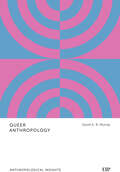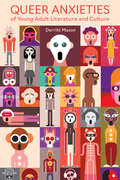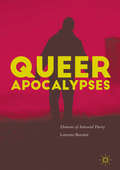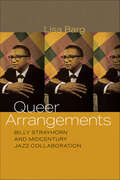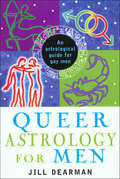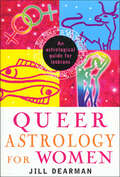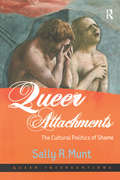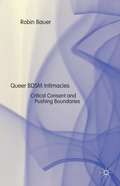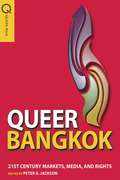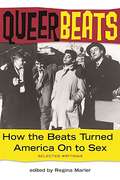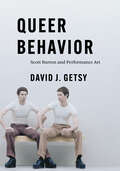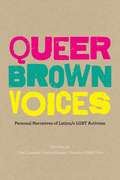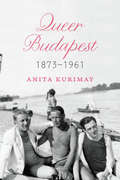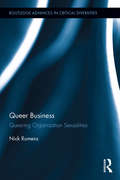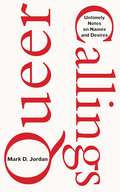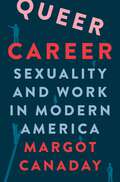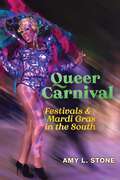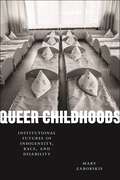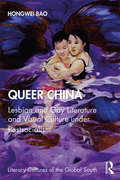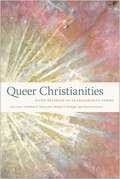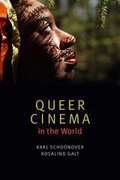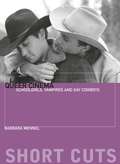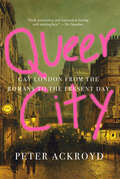- Table View
- List View
Queer Anthropology: Anthropological Insights (Anthropological Insights)
by David A.B. MurrayIn the early 1990s, “queer anthropology” represented a new and radically different approach to anthropological research on sexuality and gender, but it is now an established subfield of sociocultural anthropology. Queer Anthropology provides a concise, accessible overview of queer anthropology’s academic and activist origins, its key theoretical and methodological principles, its strengths and weaknesses, and how it has changed since its first appearance over thirty years ago. Each chapter includes discussion questions, recommended readings, and ethnographic examples to illustrate key concepts or themes. The book is written in accessible language for students, instructors, and non-specialist readers interested in how anthropologists think, research, and write about gender, sex, and sexuality. Designed for introductory anthropology, gender, and/or queer studies courses, Queer Anthropology provides important insights into the past, present, and future of queer anthropological research.
Queer Anxieties of Young Adult Literature and Culture (Children's Literature Association Series)
by Derritt MasonYoung adult literature featuring LGBTQ+ characters is booming. In the 1980s and 1990s, only a handful of such titles were published every year. Recently, these numbers have soared to over one hundred annual releases. Queer characters are also appearing more frequently in film, on television, and in video games. This explosion of queer representation, however, has prompted new forms of longstanding cultural anxieties about adolescent sexuality. What makes for a good “coming out” story? Will increased queer representation in young people’s media teach adolescents the right lessons and help queer teens live better, happier lives? What if these stories harm young people instead of helping them? In Queer Anxieties of Young Adult Literature and Culture, Derritt Mason considers these questions through a range of popular media, including an assortment of young adult books; Caper in the Castro, the first-ever queer video game; online fan communities; and popular television series Glee and Big Mouth. Mason argues themes that generate the most anxiety about adolescent culture—queer visibility, risk taking, HIV/AIDS, dystopia and horror, and the promise that “It Gets Better” and the threat that it might not—challenge us to rethink how we read and engage with young people’s media. Instead of imagining queer young adult literature as a subgenre defined by its visibly queer characters, Mason proposes that we see “queer YA” as a body of transmedia texts with blurry boundaries, one that coheres around affect—specifically, anxiety—instead of content.
Queer Apocalypses
by Lorenzo BerniniThis book is an attempt to save "the sexual" from the oblivion to which certain strands in queer theory tend to condemn it, and at the same time to limit the risks of anti-politics and solipsism contained in what has been termed antisocial queer theory. It takes a journey from Sigmund Freud to Mario Mieli and Guy Hocquenghem, from Michel Foucault and Judith Butler to Teresa de Lauretis, Leo Bersani, Lee Edelman, and Tim Dean, and from all of these thinkers back to Immanuel Kant and Thomas Hobbes. At the end, through readings of Bruce LaBruce's movies on gay zombies, the elitism of antisocial queer theory is brought into contact with popular culture. The living dead come to represent a dispossessed form of subjectivity, whose monstrous drives are counterposed to predatory desires of liberal individuals. The reader is thus lead into the interstitial spaces of the Queer Apocalypses, where the past and the future collapse onto the present, and sexual minorities resurrect to the chance of a non-heroic political agency.
Queer Arrangements: Billy Strayhorn and Midcentury Jazz Collaboration
by Lisa BargWinner of the 2024 Philip Brett Award, sponsored by the LGBTQ Study Group of the American Musicological Society (AMS)The legacy of Black queer composer, arranger, and pianist Billy Strayhorn (1915–1967) hovers at the edge of canonical jazz narratives. Queer Arrangements explores the ways in which Strayhorn's identity as an openly gay Black jazz musician shaped his career, including the creative roles he could assume and the dynamics between himself and his collaborators, most famously Duke Ellington, but also iconic singers such as Lena Horne and Ella Fitzgerald. This new portrait of Strayhorn combines critical, historically-situated close readings of selected recordings, scores, and performances with biography and cultural theory to pursue alternative interpretive jazz possibilities, Black queer historical routes, and sounds. By looking at jazz history through the instrument(s) of Strayhorn's queer arrangements, this book sheds new light on his music and on jazz collaboration at midcentury.
Queer Astrology for Men: An Astrological Guide for Gay Men
by Jill DearmanA hilariously and startlingly insightful astrology guide for gay men.Jill Dearman is a breakthrough astrologer for our time. No one has approached the stars with her sass and class ever before! Her guide to astrology for gay men is lively, revealing-- and naughty!Sections include: in life, in bed, how to seduce him, doing him and dating him, how to last over the long haul, how to get rid of him, and the three faces of each sign.And a complete compatibility profile of each astrological combination.
Queer Astrology for Women: An Astrological Guide for Lesbians
by Jill DearmanA hilariously irreverent and startlingly insightful astrology guide for lesbians.Jill Dearman is a breakthrough astrologer for our time. No one has approached the stars with her sass and class ever before! Her guide to astrology for lesbians is lively, revealing--and naughty!Sections include: in life, in bed, how to seduce her, doing her and dating her, how to last over the long haul, how to get rid of her, and the three faces of each sign.How to get rid of an Aquarius woman: Ms. Aquarius will pack her bags soon after you start invading her personal space and drowning her in too much nonstop and irrational cemotion. Ms. Aquarius hates to feel trapped, so if you slowly take away all her freedoms, you will be watching her walk out the door faster than you can sing "This is the dawning of the..."The Cancer woman is intensely emotiona...and her moods change with the tides. Not that you can every completely figure her out. Would you dare to assume you could understand the sea or fully absorb or comprehend a beautiful piece of music? Or course not, you silly lesbian. So don't patronize this lovely woman.But getting rid of a Cancer woman: Please don't be a cad and pull off the old "I'm going out for a pack of cigarettes (or a bag of Kitty Litter)" and never come back routine. She'll have your mother sitting with her and holding her hand, worrying, before you've made it past the border.And a complete compatibility profile of each astrological combination:Take Aries and Cancer: The best par? They can be fiercely loyal and protective of each other. The worst part? They instinctively know how to hurt each other's feelings and often do, in a most brutal way. Ms. Aries, ruled by fire strikes quickly and forcefully and without thinking. "Don't each that doughnut! It'll make you fat!" Ms Cancer, ruled by water, knows how to create a mood of subtle emotional torture. "I don't feel like being touched...No, I don't want to be alone. Can't we just sit together in the same room and not talk and not touch and not make such a big deal about it?"
Queer Attachments: The Cultural Politics of Shame (Queer Interventions)
by Sally R. MuntWhy is shame so central to our identity and to our culture? What is its role in stigmatizing subcultures such as the Irish, the queer or the underclass? Can shame be understood as a productive force? In this lucid and passionately argued book, Sally R. Munt explores the vicissitudes of shame across a range of texts, cultural milieux, historical locations and geographical spaces - from eighteenth-century Irish politics to Philip Pullman's His Dark Materials trilogy, from contemporary US academia to the aesthetics of Tracey Emin. She finds that the dynamics of shame are consistent across cultures and historical periods, and that patterns of shame are disturbingly long-lived. But she also reveals shame as an affective emotion, engendering attachments between bodies and between subjects - queer attachments. Above all, she celebrates the extraordinary human ability to turn shame into joy: the party after the fall. Queer Attachments is an interdisciplinary synthesis of cultural politics, emotions theory and narrative that challenges us to think about the queerly creative proclivities of shame.
Queer BDSM Intimacies
by Robin BauerThis is the first book-length empirical study of lesbian, transgender and queer BDSM practices, identities, relationships and communities. Based on interviews and participant observation, Queer BDSM Intimacies explores various women's and queer BDSM spaces and networks in the USA and Western Europe over a period of five years. While research on alternative forms of sexuality, genders and relationships has been booming recently, the particular experiences and perspectives of this group have yet to receive sufficient attention. Robin Bauer shows that queer BDSM practitioners have created unique social spaces through critical consent-making processes. These spaces are suited to explore not only their own identities beyond common binary categorizations of man/woman and homo/heterosexual, but to create new forms of living, gender, sexuality, intimacy and collectivity. The transgressive nature of BDSM allows them to push their own and social boundaries, engaging with social difference and power dynamics, appropriating them for their own pleasures.
Queer Bangkok: 21st Century Markets, Media, and Rights
by Peter A. JacksonThe Thai capital Bangkok is the unrivalled centre of the country's gay, lesbian and transgender communities. These communities are among the largest in Southeast Asia, and indeed in the world, and have a diversity, social presence and historical depth that set them apart from the queer cultures of many neighbouring societies. The first years of the 21st Century have marked a significant transition moment for all of Thailand's LGBT cultures, with a multidimensional expansion in the geographical extent, media presence, economic importance, political impact, social standing, and cultural relevance of Thai queer communities. This book analyzes the roles of the market and media - especially cinema and the Internet - in these transformations, and considers the ambiguous consequences that the growing commodification and mediatisation of queer lives have had for LGBT rights in Thailand. A key finding is that in the early 21st Century processes of global queering are leading to a growing Asianisation of Bangkok's queer cultures. This book traces Bangkok's emergence as a central focus of an expanding regional network linking gay, lesbian and transgender communities in Hong Kong, Singapore, Taiwan, Indonesia, the Philippines and other rapidly developing East and Southeast Asian societies. Peter A. Jacksonis associate professor in the School of Culture, History and Language at Australian National University. "The myriad faces of Thai gender/sexuality culture have been an attraction for both pleasure-seekers and researchers/scholars/activists. Exploring the rapidly changing LGBT cultures and Thai queer identities, the essays collected here provide insightful analyses of historical continuities as well as developing variations within the highly complex erotic/economic texture of Thai society. A must-read for anyone in the booming field of gender/sexuality studies. " -Josephine Ho, Chair Professor, Center for the Study of Sexualities, National Central University, Taiwan
Queer Beats: How the Beats Turned America On to Sex
by Regina MarlerThe writings that shocked America out of the 1950s<P> Blasting through the crew-cuts and conformism of their day, the Beat writers were queer in the fullest sense of the word: their fluid sexuality challenged all sexual and romantic conventions. Most shocking of their unconventional attitudes was their embrace of same-sex eroticism. At a time when gay people were considered mentally ill or criminal, the Beats celebrated spontaneity and freedom in thought, word, and action. Their highest value was nakedness-even before Allen Ginsberg stripped bare at a poetry reading to silence a heckler. They would try anything once, then write about it.<P> Queer Beats: How the Beats Turned America On to Sex traces, for the first time, the queer pulse that throbs throughout the Beats' writings-from William S. Burroughs's Naked Lunch and Allen Ginsberg's wistful, boy-loving sex poems to Jack Kerouac's hero-worship of Neal Cassady-and Kerouac's denial of having sex with men, despite erotic encounters with Ginsberg and Gore Vidal: "Posterity will laugh at me if it thinks I was queer."
Queer Beats: How the Beats Turned America On to Sex
by Regina MarlerThe writings that shocked America out of the 1950s Blasting through the crew-cuts and conformism of their day, the Beat writers were queer in the fullest sense of the word: their fluid sexuality challenged all sexual and romantic conventions. Most shocking of their unconventional attitudes was their embrace of same-sex eroticism. At a time when gay people were considered mentally ill or criminal, the Beats celebrated spontaneity and freedom in thought, word, and action. Their highest value was nakedness--even before Allen Ginsberg stripped bare at a poetry reading to silence a heckler. They would try anything once, then write about it. Queer Beats: How the Beats Turned America On to Sex traces, for the first time, the queer pulse that throbs throughout the Beats' writings--from William S. Burroughs's Naked Lunch and Allen Ginsberg's wistful, boy-loving sex poems to Jack Kerouac's hero-worship of Neal Cassady--and Kerouac's denial of having sex with men, despite erotic encounters with Ginsberg and Gore Vidal: "Posterity will laugh at me if it thinks I was queer."
Queer Behavior: Scott Burton and Performance Art
by David J. GetsyThe first book to chart Scott Burton’s performance art and sculpture of the 1970s. Scott Burton (1939–89) created performance art and sculpture that drew on queer experience and the sexual cultures that flourished in New York City in the 1970s. David J. Getsy argues that Burton looked to body language and queer behavior in public space—most importantly, street cruising—as foundations for rethinking the audiences and possibilities of art. This first book on the artist examines Burton’s underacknowledged contributions to performance art and how he made queer life central in them. Extending his performances about cruising, sexual signaling, and power dynamics throughout the decade, Burton also came to create functional sculptures that covertly signaled queerness by hiding in plain sight as furniture waiting to be used. With research drawing from multiple archives and numerous interviews, Getsy charts Burton’s deep engagements with postminimalism, performance, feminism, behavioral psychology, design history, and queer culture. A restless and expansive artist, Burton transformed his commitment to gay liberation into a unique practice of performance, sculpture, and public art that aspired to be antielitist, embracing of differences, and open to all. Filled with stories of Burton’s life in New York’s art communities, Queer Behavior makes a case for Burton as one of the most significant out queer artists to emerge in the wake of the Stonewall uprising and offers rich accounts of queer art and performance art in the 1970s.
Queer Brown Voices: Personal Narratives of Latina/o LGBT Activism (First Edition)
by Uriel QuesadaTo disrupt the cycle of sexism, racism, and homophobia that they experienced, LGBT Latinas/os organized themselves on local, state, and national levels, forming communities in which they could fight for equal rights while simultaneously staying true to both their ethnic and sexual identities.
Queer Budapest, 1873–1961
by Anita KurimayBy the dawn of the twentieth century, Budapest was a burgeoning cosmopolitan metropolis. Known at the time as the “Pearl of the Danube,” it boasted some of Europe’s most innovative architectural and cultural achievements, and its growing middle class was committed to advancing the city’s liberal politics and making it an intellectual and commercial crossroads between East and West. In addition, as historian Anita Kurimay reveals, fin-de-siècle Budapest was also famous for its boisterous public sexual culture, including a robust gay subculture. Queer Budapest is the riveting story of nonnormative sexualities in Hungary as they were understood, experienced, and policed between the birth of the capital as a unified metropolis in 1873 and the decriminalization of male homosexual acts in 1961. Kurimay explores how and why a series of illiberal Hungarian regimes came to regulate but also tolerate and protect queer life. She also explains how the precarious coexistence between the illiberal state and queer community ended abruptly at the close of World War II. A stunning reappraisal of sexuality’s political implications, Queer Budapest recuperates queer communities as an integral part of Hungary’s—and Europe’s—modern incarnation.
Queer Business: Queering Organization Sexualities (Routledge Advances in Critical Diversities)
by Nick RumensIn this modern day and age, it is surprising that managerialist perspectives, practices and ideas are colonising the study of sexualities in organisation. A timely intervention into the contemporary vitality of queer theories, Queer Business is an innovative book length exploration of how queer theory has been used in management and organisation studies, with the aim of broadening and deepening queer scholarship in this discipline. Through both scholarly and original empirical research, Rumens also seeks to demonstrate how queer theory has been mobilised in MOS and how it might be advanced in a field where it has yet to become exhausted and clichéd. In particular, this volume shows how scholars can use queer theory concepts to explore how lesbian, gay, bisexual and transgender sexualities and genders are understood and experienced in the workplace. Challenging notions of LGBT+ inclusivity in the workplace through concepts such as queer liberalism and homonormativity, Queer Business will appeal to scholars, undergraduate and postgraduate students and postdoctoral researchers interested in fields such as management and organisation studies, queer studies, gender studies, sexuality studies, organisational theory and cultural studies.
Queer Callings: Untimely Notes on Names and Desires
by Mark D. JordanCHOICE: OUTSTANDING ACADEMIC TITLEFINALIST, THE RANDY SHILTS AWARD FOR GAY NONFICTION, THE PUBLISHING TRIANGLE AWARDSA passionate exhortation to expand the ways we talk about human sex, sexuality, and gender.Twenty-five years ago, Mark D. Jordan published his landmark book on the invention and early history of the category “sodomy,” one that helped to decriminalize certain sexual acts in the United States and to remove the word sodomy from the updated version of a standard English translation of the Christian Bible. In Queer Callings, Jordan extends the same kind of illuminating critical analysis to present uses of “identity” with regard to sexual difference. While the stakes might not seem as high, he acknowledges, his newest history of sexuality is just as vital to a better present and future.Shaking up current conversations that focus on “identity language,” this essential new book seeks to restore queer languages of desire by inviting readers to consider how understandings of “sexual identity” have shifted—and continue to shift—over time. Queer Callings re-reads texts in various genres—literary and political, religious and autobiographical—that have been preoccupied with naming sex/gender diversity beyond a scheme of LGBTQ+ identities. Engaging a wide range of literary and critical works concerned with sex/gender self-understanding in relation to “spirituality,” Jordan takes up the writings of Oscar Wilde, Marcel Proust, Djuna Barnes, Samuel R. Delany, Audre Lorde, Geoff Mains, Eve Kosofsky Sedgwick, Gloria Anzaldúa, Maggie Nelson, and others.Before it’s possible to perceive sexual identities differently, Jordan argues, current habits for classifying them have to be disrupted. In this way, Queer Callings asks us to reach beyond identity language and invites us to re-perform a selection of alternate languages—some from before the invention of phrases like “sexual identity,” others more recent. Tracing a partial genealogy for “sexual identity” and allied phrases, Jordan reveals that the terms are newer than we might imagine. Many queer folk now counted as literary or political ancestors didn’t claim a sexual or gender identity: They didn’t know they were supposed to have one. Finally, Queer Callings joins the writers it has evoked to resist any remaining confidence that it’s possible to give neatly contained accounts of human desire. Reaching into the past to open our eyes to extraordinary opportunities in our present and future, Queer Callings is a generatively destabilizing and essential read.
Queer Career: Sexuality and Work in Modern America
by Margot CanadayA masterful history of the queer workforce in AmericaWorkplaces have traditionally been viewed as &“straight spaces&” in which queer people passed. As a result, historians have directed limited attention to the experiences of queer people on the job. Queer Career rectifies this, offering an expansive historical look at sexual minorities in the modern American workforce. Arguing that queer workers were more visible than hidden and, against the backdrop of state aggression, vulnerable to employer exploitation, Margot Canaday positions employment and fear of job loss as central to gay life in postwar America.Rather than finding that many midcentury employers tried to root out gay employees, Canaday sees an early version of &“don&’t ask / don&’t tell&”: in all kinds of work, as long as queer workers were discreet, they were valued for the lower wages they could be paid, their contingency, their perceived lack of familial ties, and the ease with which they could be pulled in and pushed out of the labor market. Across the socioeconomic spectrum, they were harbingers of post-Fordist employment regimes we now associate with precarity. While progress was not linear, by century&’s end some gay workers rejected their former discretion, and some employers eventually offered them protection unattained through law. Pushed by activists at the corporate grass roots, business emerged at the forefront of employment rights for sexual minorities. It did so, at least in part, in response to the way that queer workers aligned with, and even prefigured, the labor system of late capitalism.Queer Career shows how queer history helps us understand the recent history of capitalism and labor and rewrites our understanding of the queer past.
Queer Carnival: Festivals and Mardi Gras in the South
by Amy L. StoneThe importance of citywide festivals like Mardi Gras and Fiesta for the LGBTQ communityFestivals like Mardi Gras and Fiesta have come to be annual events in which entire cities participate, and LGBTQ people are a visible part of these celebrations. In other words, the party is on, the party is queer, and everyone is invited. In Queer Carnival, Amy Stone takes us inside these colorful, eye-catching, and often raucous events, highlighting their importance to queer life in America’s urban South and Southwest. Drawing on five years of research, and over a hundred days at LGBTQ events in cities such as San Antonio, Santa Fe, Baton Rouge, and Mobile, Stone gives readers a front-row seat to festivals, carnivals, and Mardi Gras celebrations, vividly bringing these queer cultural spaces and the people that create and participate in them to life. Stone shows how these events serve a larger fundamental purpose, helping LGBTQ people to cultivate a sense of belonging in cities that may be otherwise hostile. Queer Carnival provides an important new perspective on queer life in the South and Southwest, showing us the ways that LGBTQ communities not only survive, but thrive, even in the most unexpected places.
Queer Childhoods: Institutional Futures of Indigeneity, Race, and Disability (Sexual Cultures)
by Mary ZaborskisExplores how the institutional management of children’s sexualities in boarding schools affected children’s future social, political, and economic opportunities Tracing the US’s investment in disciplining minoritarian sexualities since the late nineteenth century, Mary Zaborskis focuses on a ubiquitous but understudied figure: the queer child. Queer Childhoods examines the lived and literary experiences of children who attended reform schools, schools for the blind, African American industrial schools, and Native American boarding schools. In mapping the institutional terrain of queer childhoods in educational settings of the late nineteenth- and twentieth-century, the book offers an original archive of children’s sexual and embodied experiences. Zaborskis argues that these boarding schools—designed to segregate racialized, criminalized, and disabled children from mainstream culture—produced new forms of childhood. These childhoods have secured American futures in which institutionalized children (and the adults they become) have not been considered full-fledged citizens or participants. By locating this queerness in state archives and institutions, Queer Childhoods exposes a queer social history entangled with genocide, eugenics, and racialized violence.
Queer China: Lesbian and Gay Literature and Visual Culture under Postsocialism (Literary Cultures of the Global South)
by Hongwei BaoThis book analyses queer cultural production in contemporary China to map the broad social transformations in gender, sexuality and desire. It examines queer literature and visual cultures in China’s post-Mao and postsocialist era to show how these diverse cultural forms and practices not only function as context-specific and culturally sensitive forms of social activism but also produce distinct types of gender and sexual subjectivities unique to China’s postsocialist conditions. From poetry to papercutting art, from ‘comrade/gay literature’ to girls’ love fan fiction, from lesbian films to activist documentaries, and from a drag show in Shanghai to a public performance of a same-sex wedding in Beijing, the book reveals a queer China in all its ideological complexity and creative energy. Empirically rich and methodologically eclectic, Queer China skilfully weaves together historical and archival research, textual and discourse analysis, along with interviews and ethnography. Breaking new ground and bringing a non-Western perspective to the fore, this transdisciplinary work contributes to multiple academic fields including literary and cultural studies, media and communication studies, film and screen studies, contemporary art, theatre and performance studies, gender and sexuality studies, China/Asia and Global South studies, cultural history and cultural geography, political theory and the study of social movements.
Queer Chivalry: Medievalism and the Myth of White Masculinity in Southern Literature (Southern Literary Studies)
by Tison PughFor the U.S. South, the myth of chivalric masculinity dominates the cultural and historical landscape. Visions of white southern men as archetypes of honor and gentility run throughout regional narratives with little regard for the actions and, at times, the atrocities committed by such men. In Queer Chivalry, Tison Pugh exposes the inherent contradictions in these depictions of cavalier manhood, investigating the foundations of southern gallantry as a reincarnated and reauthorized version of medieval masculinity. Pugh argues that the idea of masculinity -- particularly as seen in works by prominent southern authors from Mark Twain to Ellen Gilchrist -- constitutes a cultural myth that queerly demarcates accepted norms of manliness, often by displaying the impossibility of its achievement. Beginning with Twain's famous critique of "the Sir Walter disease" that pilloried the South, Pugh focuses on authors who questioned the code of chivalry by creating protagonists whose quests for personal knighthood prove quixotic. Through detailed readings of major works -- including Twain's A Connecticut Yankee in King Arthur's Court, Flannery O'Connor's short fiction, John Kennedy Toole's A Confederacy of Dunces, Robert Penn Warren's A Place to Come To, Walker Percy's novels, and Gilchrist's The Annunciation -- Pugh demonstrates that the hypermasculinity of white-knight ideals only draws attention to the ambiguous gender of the literary southern male.Employing insights from gender and psychoanalytic theory, Queer Chivalry contributes to recent critical discussions of the cloaked anxieties about gender and sexuality in southern literature. Ultimately, Pugh uncovers queer limits in the cavalier mythos, showing how facts and fictions contributed to the ideological formulation of the South.
Queer Christianities: Lived Religion in Transgressive Forms
by Kathleen T. Talvacchia, Michael F. Pettinger, and Mark LarrimoreQueerness and Christianity, often depicted as mutually exclusive, both challenge received notions of the good and the natural. Nowhere is this challenge more visible than in the identities, faiths, and communities that queer Christians have long been creating. As Christians they have staked a claim for a Christianity that is true to their self-understandings. How do queer-identified persons understand their religious lives? And in what ways do the lived experiences of queer Christians respond to traditions and reshape them in contemporary practice? Queer Christianities integrates the perspectives of queer theory, religious studies, and Christian theology into a lively conversation—both transgressive and traditional—about the fundamental questions surrounding the lives of queer Christians. The volume contributes to the emerging scholarly discussion on queer religious experiences as lived both within communities of Christian confession, as well as outside of these established communities.Organized around traditional Christian states of life—celibacy, matrimony, and what is here provocatively conceptualized as promiscuity—this work reflects the ways in which queer Christians continually reconstruct and multiply the forms these states of life take. Queer Christianities challenges received ideas about sexuality and religion, yet remains true to Christian self-understandings that are open to further enquiry and to further queerness.
Queer Cinema in the World
by Rosalind Galt Karl SchoonoverProposing a radical vision of cinema's queer globalism, Karl Schoonover and Rosalind Galt explore how queer filmmaking intersects with international sexual cultures, geopolitics, and aesthetics to disrupt dominant modes of world making. Whether in its exploration of queer cinematic temporality, the paradox of the queer popular, or the deviant ecologies of the queer pastoral, Schoonover and Galt reimagine the scope of queer film studies. The authors move beyond the gay art cinema canon to consider a broad range of films from Chinese lesbian drama and Swedish genderqueer documentary to Bangladeshi melodrama and Bolivian activist video. Schoonover and Galt make a case for the centrality of queerness in cinema and trace how queer cinema circulates around the globe-institutionally via film festivals, online consumption, and human rights campaigns, but also affectively in the production of a queer sensorium. In this account, cinema creates a uniquely potent mode of queer worldliness, one that disrupts normative ways of being in the world and forges revised modes of belonging.
Queer Cinema: Schoolgirls, Vampires, and Gay Cowboys (Short Cuts)
by Barbara MennelQueer Cinema: Schoolgirls, Vampires, and Gay Cowboys illustrates queer cinematic aesthetics by highlighting key films that emerged at historical turning points throughout the twentieth century. Barbara Mennel traces the representation of gays and lesbians from the sexual liberation movements of the roaring 1920s in Berlin to the Stonewall Rebellion in New York City and the emergence of queer activism and film in the early 1990s. She explains early tropes of queerness, such as the boarding school or the vampire, and describes the development of camp from 1950s Hollywood to underground art of the late 1960s in New York City. Mennel concludes with an exploration of the contemporary mainstreaming of gay and lesbian films and global queer cinema. Queer Cinema: Schoolgirls, Vampires and Gay Cowboys not only offers an introduction to a gay and lesbian film history, but also contributes to an academic discussion about queer subversion of mainstream film.
Queer City: Gay London from the Romans to the Present Day
by Peter AckroydA history of the development of London as a European epicenter of queer life.In Queer City, the acclaimed Peter Ackroyd looks at London in a whole new way–through the complete history and experiences of its gay and lesbian population. In Roman Londinium, the city was dotted with lupanaria (“wolf dens” or public pleasure houses), fornices (brothels), and thermiae (hot baths). Then came the Emperor Constantine, with his bishops, monks, and missionaries. And so began an endless loop of alternating permissiveness and censure. Ackroyd takes us right into the hidden history of the city; from the notorious Normans to the frenzy of executions for sodomy in the early nineteenth century. He journeys through the coffee bars of sixties Soho to Gay Liberation, disco music, and the horror of AIDS. Ackroyd reveals the hidden story of London, with its diversity, thrills, and energy, as well as its terrors, dangers, and risks, and in doing so, explains the origins of all English-speaking gay culture.Praise for Queer City“Spanning centuries, the book is a fantastically researched project that is obviously close to the author’s heart…. An exciting look at London’s queer history and a tribute to the “various human worlds maintained in [the city’s] diversity despite persecution, condemnation, and affliction.””—Kirkus Reviews“[Ackroyd’s] work is highly anecdotal and near encyclopedic . . . the book is fascinating in its careful exposition of the singularities—and commonalities—of gay life, both male and female. Ultimately it is, as he concludes, a celebration as well as a history,” —Booklist“A witty history-cum-tribute to gay London, from the Roman “wolf dens” through Oscar Wilde and Gay Pride marches to the present day,” —ShelfAwareness
